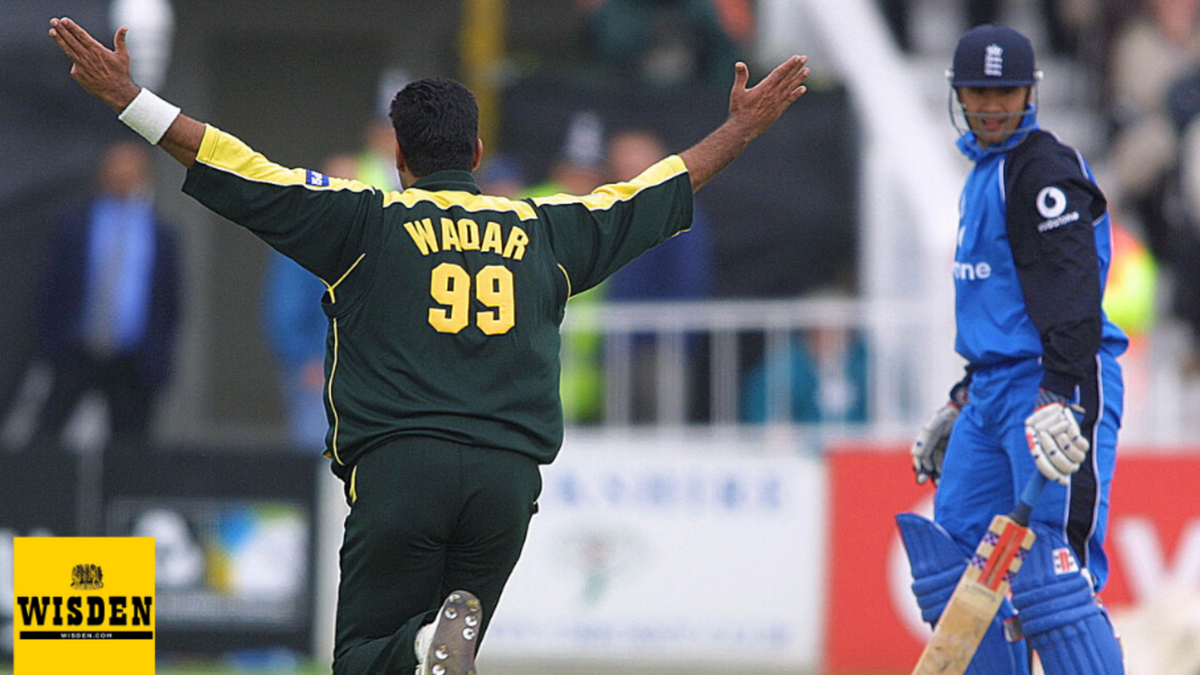
In the end, England conceded the match after a shameful pitch invasion, but the real running through was done much before, when Waqar Younis bulldozed through England in typical Waqar fashion. The spell was ranked fourth in Wisden’s 2000s in Review series.
Waqar Younis 7-36
England v Pakistan, NatWest Series
Headingley, Leeds
June 17, 2001
Waqar’s seven-wicket masterclass craftily disassembled England after they were put in to bat on a sticky Headingley wicket, shrouded by cloud cover for the most part. It wasn’t all-out pace; nearing 30, and loosened up by his constant injury run-ins, he had devised ways to let swing do it for him.
The theme was established off the very first delivery. Marcus Trescothick was rattled by a yorker upfront – not a Waqar delivery you would want to warm up to. It wasn’t rapid, just the subtle jag off the seam, the accuracy enough to undo his stumps. Trescothick stared at the splattered sticks longer than a cursory look.
His opening partner, Nick Knight, battled a springy Fazl-e-Akbar at the other end, before becoming Waqar’s second scalp. Cautiously treading the seam-bowling tightrope, Knight was foxed by a delivery that pitched on leg and sprung up and across to off – all the batsman could do was sheepishly poke it to backward point. Peach. Knight looked both aghast and awestruck.
In walked Michael Vaughan, his initiation to ODI cricket thus far being a string of single-digit scores. He tried to drive his problems away, a few play-and-a-misses were followed by a chip to cover, where Mohammad Yousuf spilt an absolute dolly. The very next over, Waqar’s nagging accuracy made up for it, forcing the batsman to fish outside off again, but this time, right into Younis Khan’s safe hands at third slip. Vaughan trudged back, just 45 runs in his first six ODI gigs.
Waqar was hitting no higher than the early 130s (kph) on the speed gun. The movement off the pitch was subtle enough, but his rhythm that day was distinctly beautiful. The left hand, leading his action, looked incredibly fluid.
After 11 overs, the score read 32-3. With neither Graham Thorpe nor Nasser Hussain around, Alec Stewart, the senior statesman stranded at one end, had a clear look of bother.
A fresh-faced Owais Shah, a week into his England career, was up next, carrying the confidence of the fiesty 62 he hit against the same opposition in their previous game. Off his very first delivery, Shah’s trademark shuffle missed a length ball and looked like a sure-shot lbw candidate, but umpire Mervyn Kitchen thought otherwise. Pakistan were convinced. It took Stewart to send an upset Waqar back to his run-up mark.
There was no Shah valour on show that day, for another length ball, this time on off stump, forced him to play at it, the outside half of the bat throwing the ball to first slip. In at six, Paul Collingwood was welcomed with a star cast of four slip fielders. Rooted to the crease and trying to guard his off stump, he ended up guiding his first ball to Younis at third slip.
Stewart, having hung around for close to fifty deliveries, tried to flick one away to mid-wicket, but a leading edge bobbled only as far as mid-off. With six wickets in his back, Pakistan decided to bowl out Waqar in the 19th over itself – he ended his spell as he had started it, a scorching yorker directed to the stumps. Cork managed bat on it, but the thick edge flew to Rashid Latif. The sorry scorecard read 58-7, all of those wickets in Waqar’s pocket.
Waqar’s seven-wicket splash was the second-best ODI figures ever recorded at that time – what more, he followed it up with six wickets against Australia in the very next game. The 2001 Waqar might not have been at his peak, but his seam bowling was still of the highest skill.








